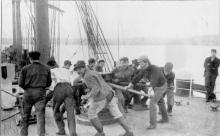Sea Shanties
Down EastersDown Easter downeaster; down-easter
Merchant sailing ship developed in Maine in the 19th century and designed for maximum carrying capacity with minimal crew size.
Read more and other early square-riggedSquare-rigged
The arrangement of sails in a vessel where the main driving sails are laced to yards lying square to the mast. It is the oldest type of known rig. Such a vessel is called a square rigger. ships had no steam or electric power to operate winchesWinch
A motor-driven or hand-powered drum used for hoisting or hauling Around the drum a chain or rope is wound attached to to the load.
Read more, capstansCapstan
A machine used on board ship to provide mechanical power to raise the anchor, hoist yards, or lift heavy weights. The capstan consists of a cast-steel barrel mounted on a vertical spindle and smallest in diameter around the middle, to allow for the rope to wind up or down as the capstan is turned. At the top of the barrel, capstan bars are fitted into slots (pigeon holes) to allow sailors to turn the capstan. and pumps. Work had to be done by the crew, using the mechanical advantageMechanical advantage
Extra power or strength obtained by using a simple machine. provided by leverage and gearsGear
The ropes, blocks, and tackles of a particular sail or spar. In more general terms, gear refers to any arrangement of machinery.
Read More. Jobs requiring teamwork were accompanied by shantiesSea shanty chantey
A rhythmic work song with a repeating chorus, often of a call-and-response format, used aboard ship to help with group tasks such as raising the anchor.: the work songs of the sea.
Sea shanties were sung by sailors to help them synchronize their efforts. There were different kinds for different kinds of work. Some had a “call and response” form that helped haul the halyardsHalyard halliard
A rope used for hoisting or lowering yards, spars, or sails on their respective masts or stays. From "haul yard." or pull in a sheetSheet sheets
The controlling line attached to a sail.. For these halyard shanties, the shantyman sang the verse, and all of the crew, pulling together, sang the choruses. The capstan shanties were longer songs designed to keep up spirits and tempo while raising the anchor. These shanties usually had more melody and often came from popular songs ashore. As they were sung, the seamen heaved, or pushed, on the capstan bars, turning the capstan and bringing in the anchor. Our movies demonstrate hauling up the halyard and the use of sea shanties.
We know that shanties were common aboard American ships in the 1830s, when Richard Henry Dana went to sea. He described them in his book, Two Years Before the Mast. (see Resource List.)

